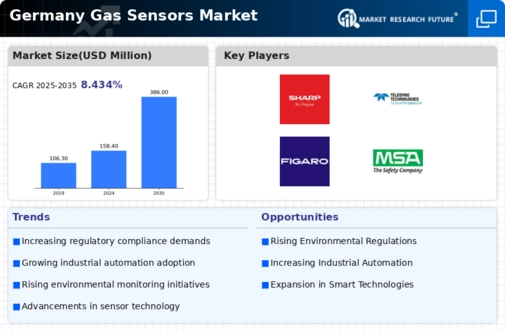Rising Industrial Demand
The gas sensors market in Germany is experiencing a notable surge in demand driven by various industrial sectors. Industries such as manufacturing, oil and gas, and chemicals are increasingly adopting gas sensors to monitor air quality and ensure workplace safety. The market is projected to grow at a CAGR of approximately 7.5% from 2025 to 2030, reflecting the heightened awareness of hazardous gas emissions. This growth is further supported by the need for real-time monitoring systems that can detect gas leaks and prevent accidents. As industries expand, the integration of advanced gas sensors becomes essential for compliance with safety regulations and operational efficiency. Consequently, the rising industrial demand is a pivotal driver for the gas sensors market, fostering innovation and technological advancements in sensor technologies.
Environmental Regulations
Germany's stringent environmental regulations significantly influence the gas sensors market. The government has implemented various policies aimed at reducing emissions and improving air quality, which necessitates the use of gas sensors for monitoring pollutants. For instance, the Federal Environment Agency mandates regular emissions testing for industrial facilities, thereby increasing the demand for reliable gas detection systems. The market is expected to benefit from these regulations, as companies seek to comply with legal requirements and avoid penalties. Furthermore, the push towards sustainable practices and the transition to renewable energy sources also drive the need for gas sensors to monitor emissions from alternative energy systems. As a result, environmental regulations serve as a crucial driver for the gas sensors market, promoting the adoption of advanced monitoring technologies.
Growing Awareness of Health Risks
The growing awareness of health risks associated with gas exposure is a significant driver for the gas sensors market in Germany. Public health campaigns and educational initiatives have heightened the understanding of the dangers posed by toxic gases, such as carbon monoxide and volatile organic compounds. This awareness has led to increased demand for gas sensors in residential, commercial, and industrial settings. The market is anticipated to expand as consumers and businesses prioritize safety and health, investing in gas detection systems to mitigate risks. Furthermore, the rise in indoor air quality concerns has prompted the adoption of gas sensors in homes and workplaces, contributing to the overall growth of the gas sensors market. As health consciousness continues to rise, the demand for effective gas monitoring solutions is likely to increase.
Investment in Research and Development
Investment in research and development (R&D) is a critical driver for the gas sensors market in Germany. Companies are increasingly allocating resources to innovate and enhance gas sensor technologies, focusing on improving accuracy, sensitivity, and response times. This emphasis on R&D is essential for staying competitive in a rapidly evolving market. The gas sensors market is projected to benefit from advancements in materials science and nanotechnology, which could lead to the development of next-generation sensors. Furthermore, collaboration between academic institutions and industry players is fostering innovation, resulting in the introduction of novel gas detection solutions. As R&D efforts intensify, the gas sensors market is likely to witness significant advancements, ultimately enhancing the capabilities and applications of gas sensors across various sectors.
Technological Integration in Smart Systems
The integration of gas sensors into smart systems is transforming the gas sensors market in Germany. With the rise of the Internet of Things (IoT) and smart city initiatives, gas sensors are increasingly being embedded in various applications, including smart homes and industrial automation. This technological integration allows for real-time data collection and analysis, enhancing the efficiency of gas monitoring systems. The market is projected to witness a growth rate of around 8% annually as more devices become interconnected. Additionally, advancements in sensor technology, such as miniaturization and improved sensitivity, are likely to drive innovation in the gas sensors market. As smart systems become more prevalent, the demand for sophisticated gas sensors that can seamlessly integrate with these technologies is expected to rise, further propelling market growth.














Leave a Comment